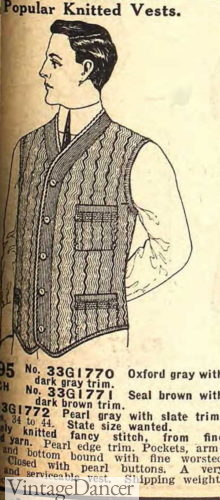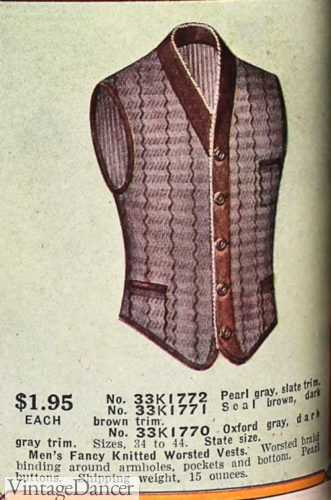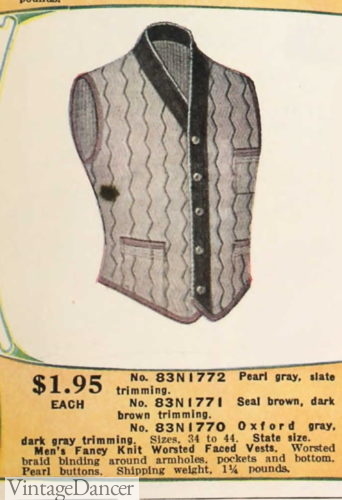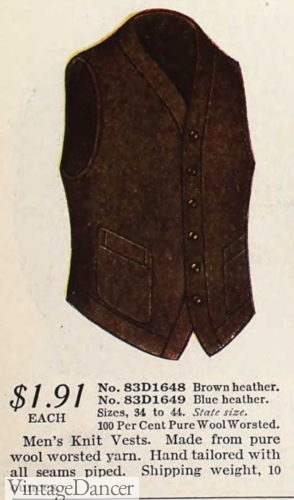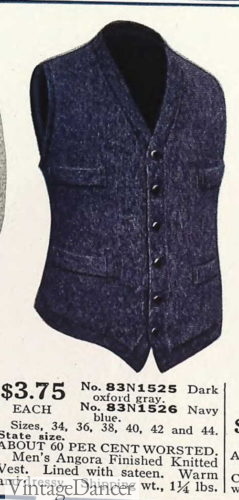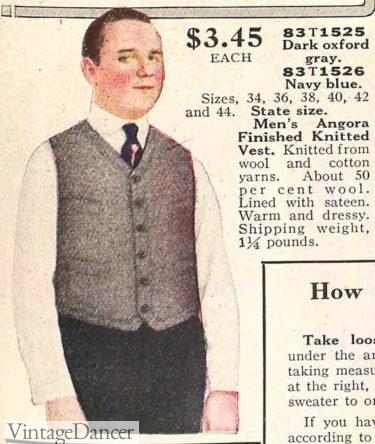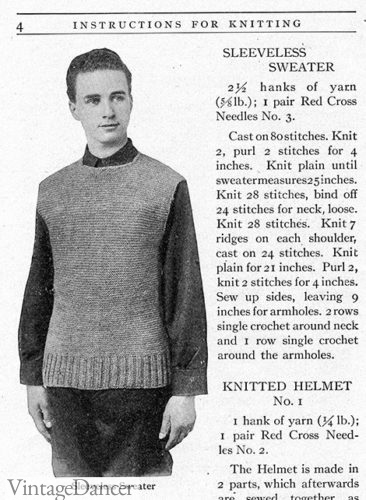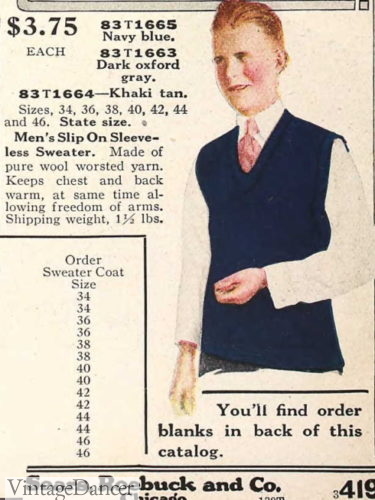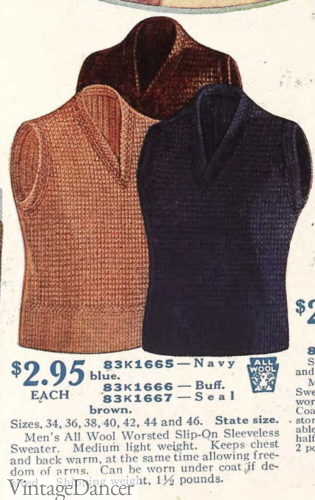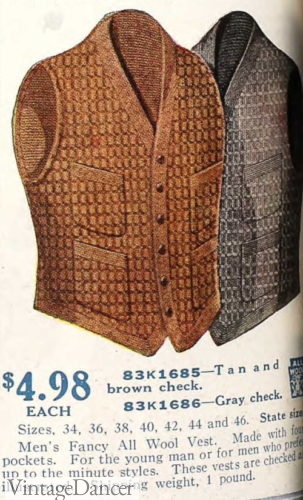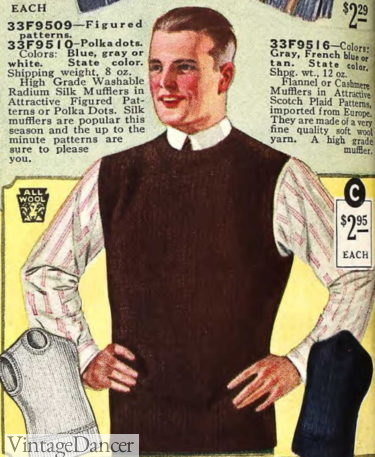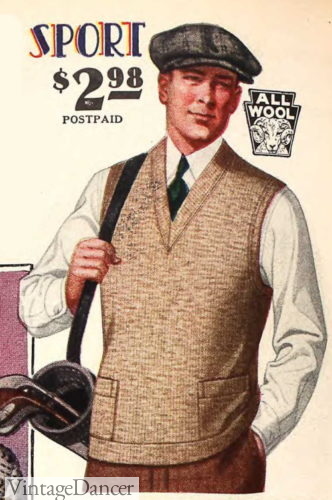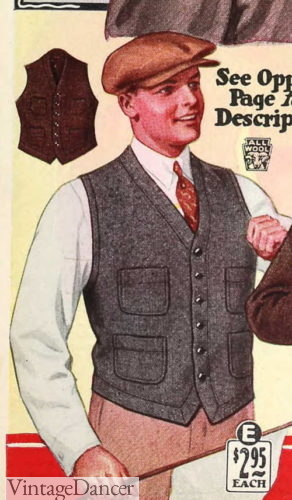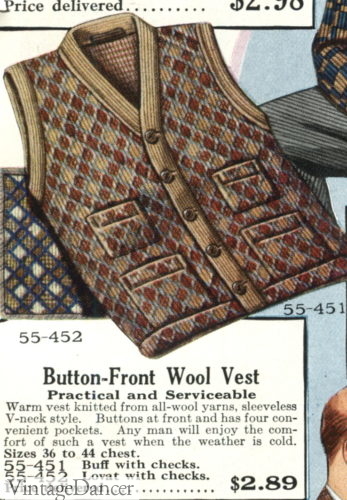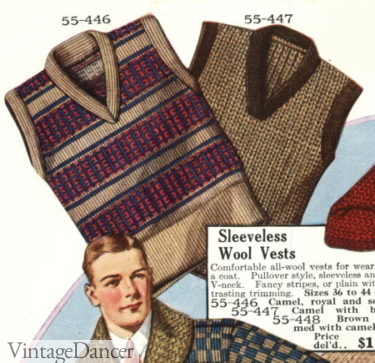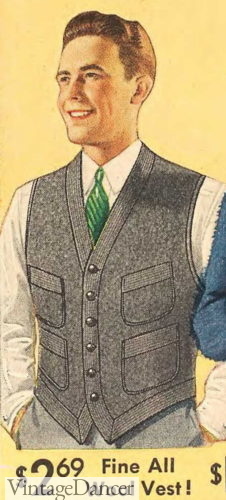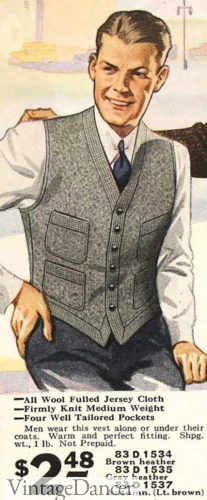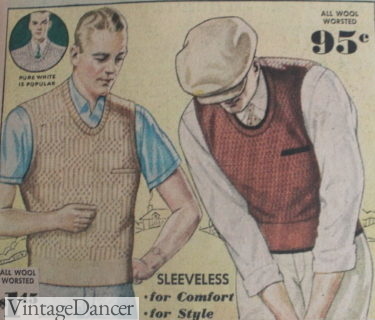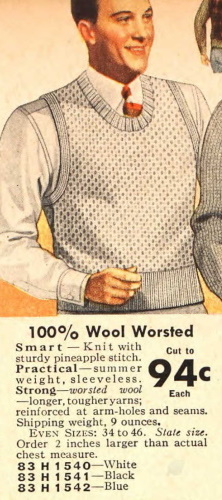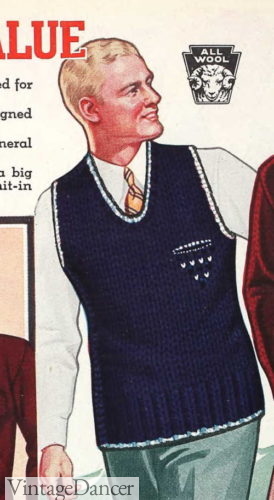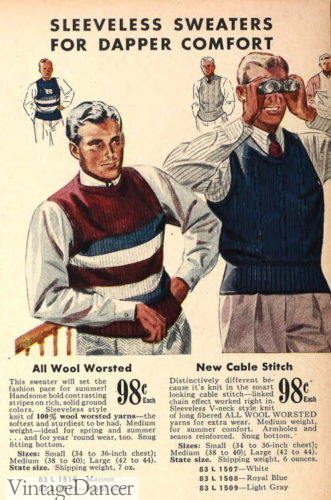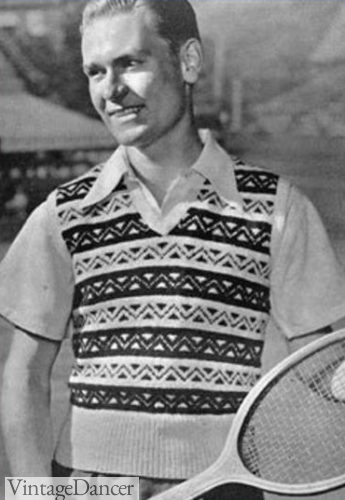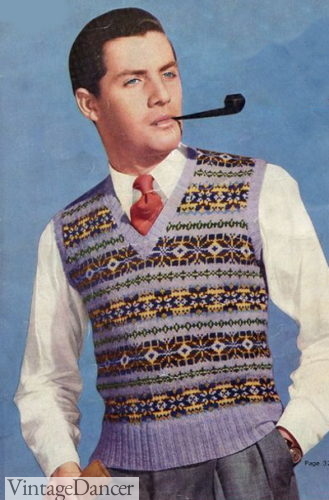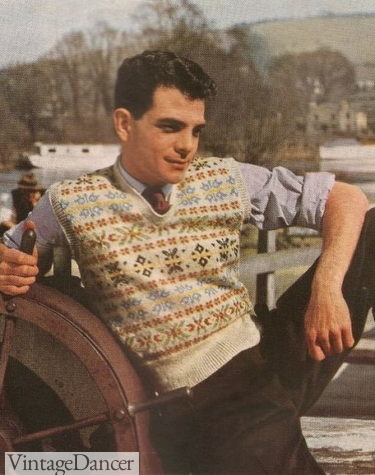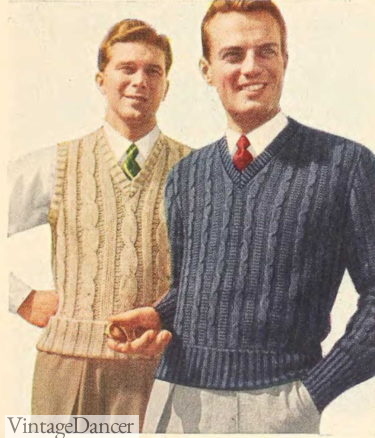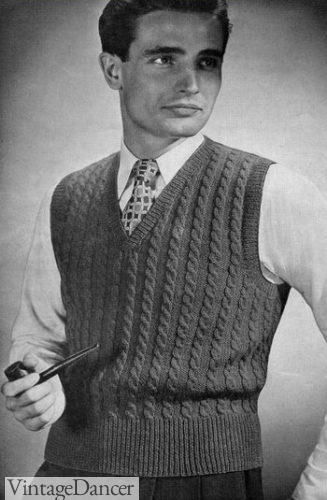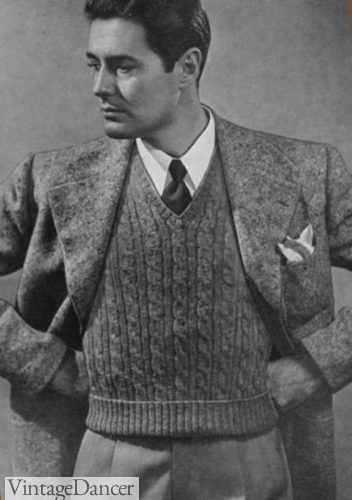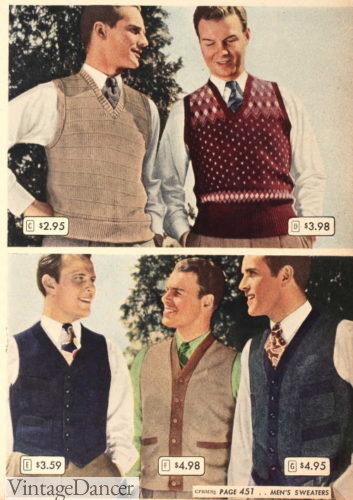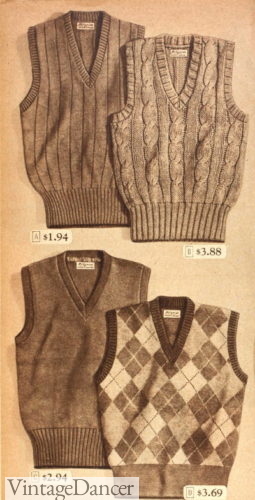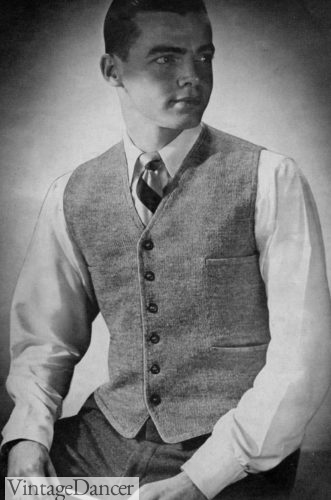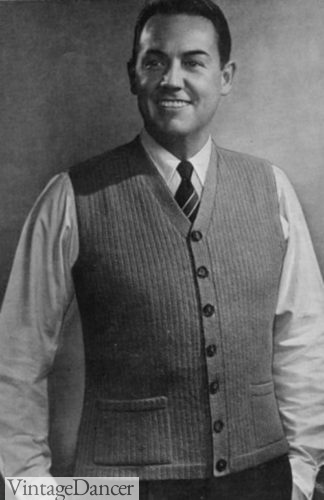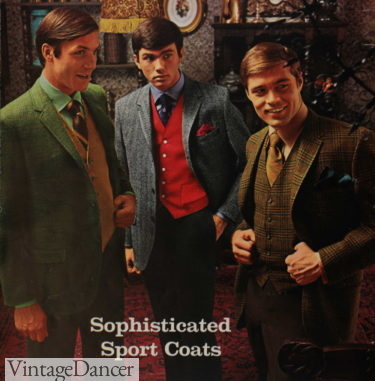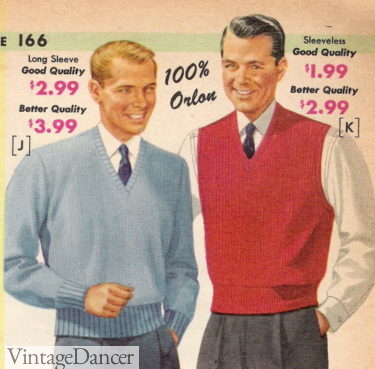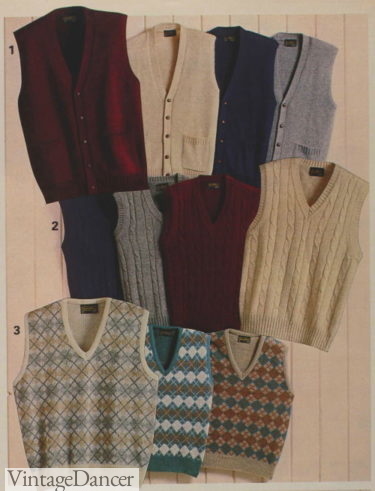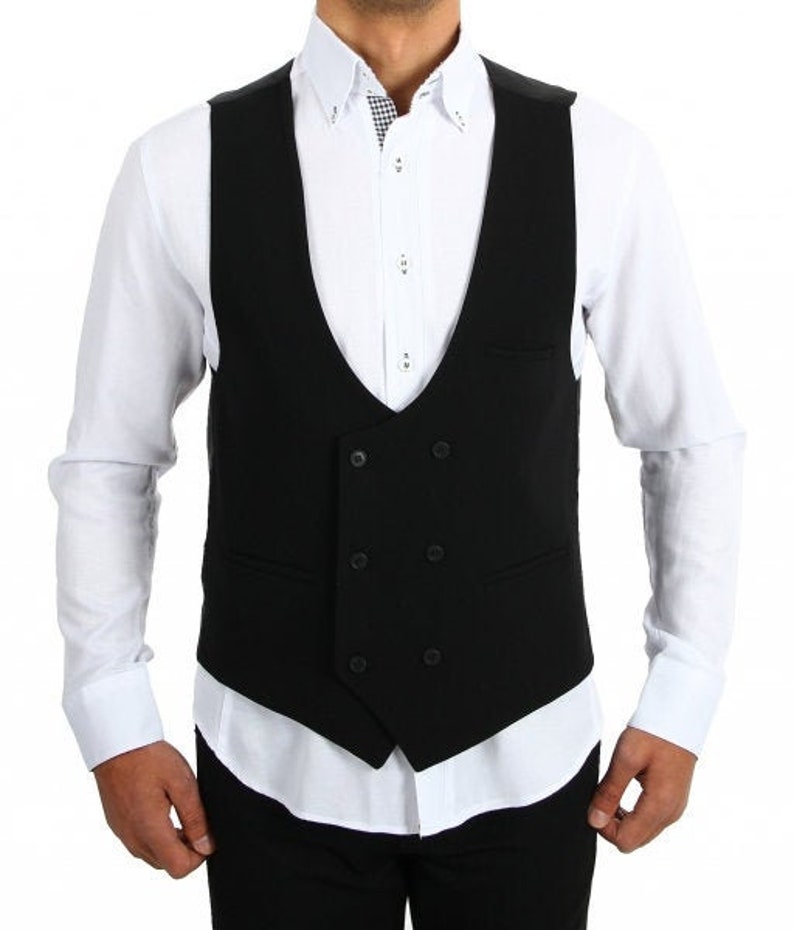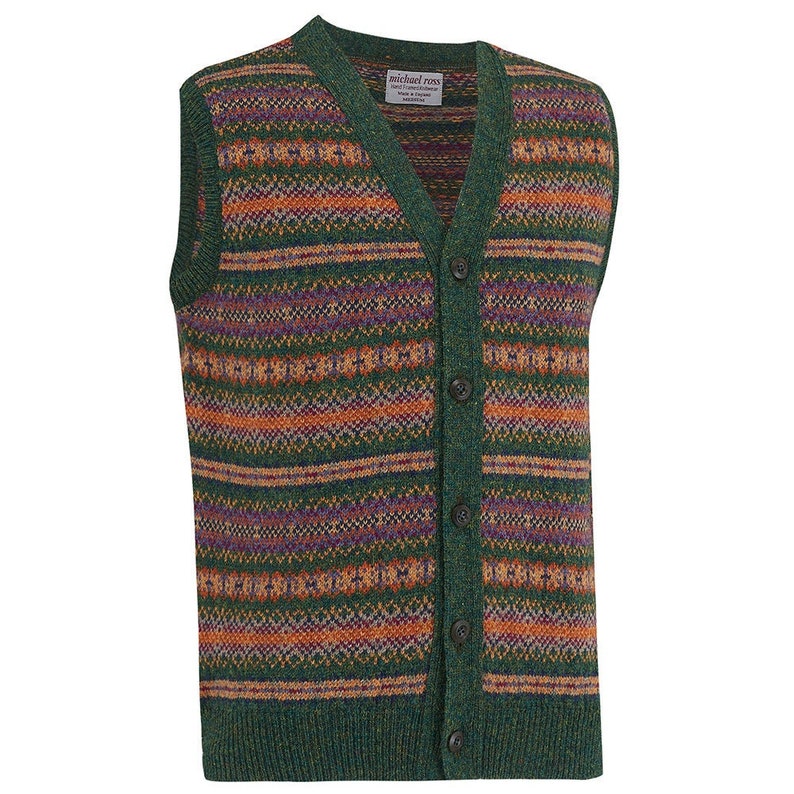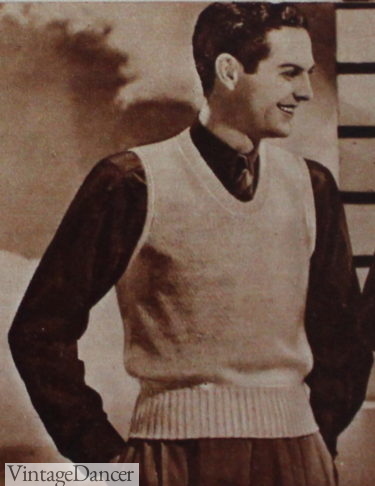
1938 men’s sweater vest
The men’s sweater vest, sleeveless sweater, knitted waistcoat, and sleeveless jumper are some of the names for pullover and button-down style cardigans without sleeves. They were a staple in men’s casual and semi-dressy wardrobe beginning in the 1910s, with especially heavy use in the 1930s and 1940s. When dressing in classic menswear or vintage style, it is imperative to include a knitted sweater vest. But what style of men’s vintage sweater vest do you buy?
This brief history article will show you some illustrations and photographs of men’s sweater vests from the 1910s, 1920s, 1930s and 1940s. Part two will cover the 1950s to 1980s. To buy many of these styles made new, look here.
1910s Men’s Sweater Vests
Looking through my vast amount of illustrations and history books, I did not find any examples of men’s sweater vests before 1910. Knitwear in general wasn’t exceptionally common among the middle and upper classes, and thus not documented in surviving resources. Men’s working class clothing often included knitwear such as pullover sweaters and cardigans. Sleeveless sweaters, however, were rare, preferring a woven wool vest or leather vest for warmth and durability.
It wasn’t until the late Edwardian period, 1910s, that menswear retailers were starting to place knitwear among sportswear (casual clothing) for the upper classes. This shift opened up men’s knitwear into new styles that blended formalwear (suits) with the comfort of knits (workwear).
While men’s pullover sweaters/ jumpers, button down cardigans, turtlenecks, and jersey shirts were plentiful, the sleeveless sweater was still uncommon.
- 1911 Wool Cardigan Vest
- 1912 Cardigan Vest
- 1913 Cardigan Vest
The first example I found was from a 1911 Sears catalog. It was in the style of a waistcoat — that is, a suit vest that buttoned down the front, with a V neckline and small pockets. These replaced men’s suit vests for very casual or country outfits, or were worn with other sport separates and workwear.
These knitted vests / knitted waistcoats are described as two tone with a lighter body and a dark tonal edging: Oxford grey/dark grey, brown/dark brown, pearl gray/slate gray. They had a fancy vertical zig zag stitch and and pearl edge trim. Most had five buttons down the center and three chest pockets with pearl buttons.
Moving into War time, the fancy stitching was lost and plain, solid colors with 2-4 pockets was the new style. Some vests were now lined with silk or sateen, which helped them keep their shape. Wool was now blended with cotton to make them lighter and cheaper, and a brushed effect called Angora (not the rabbit fur) made them look like real Shetland wool.
- 1915 Brown Knit One Pocket Cardigan Vest
- 1918 Men’s Waistcoat Sweater Vest
- 1919 Men’s Waistcoat Vest
WWI shifted men’s knitted vests into the pullover style when the military supplied men with very simple, khaki colored, sleeveless sweaters. These were often knitted by family members back home.
After the first World War, men continued to wear their sleeveless sweaters, enjoying their warmth and comfort. Menswear designers caught on to the trend and made pullover sweater vests called slip-on sweaters with a V neckline and snug, fitted shape fashionable for casualwear. They were worn over a button down shirt and necktie.
- WWI Pattern for Knitted Sleeveless Sweater
- 1919 Men’s Pullover Sleeveless Sweater Vest
1920s Men’s Sweater Vests
Men’s sweater vests continued in the early 1930s, mostly unchanged. One newer look featured a straight front edge instead of V points (a common workwear vest shape). The V neckline was small and very high, overlapping the edges of the shirt collar and exposing only the knot of the necktie. They were short waisted too, overlapping the high waisted trousers.
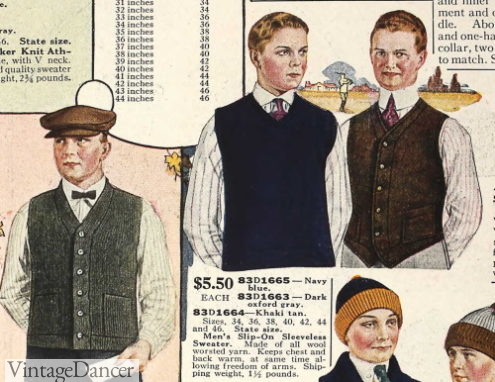
1920 Waistcoat and Pullover Sweater Vests
Some new stitch patterns were also present, such as thin vertical rows and small squared checks. Both the V-neck slipover with a ribbed waistband as well as the button down cardigan-style vests came in drab colors – navy blue, grey, brown, and khaki.
- 1922 Check Pattern Knit Slipover Vests
- 1922 Check Knit Cardigan Vests
In the mid 1920s, we start to see a few more experiments with the pullover sweater vest. New round crew necks provided added warmth and 2-4 pockets at the front were useful for holding golf balls, pencils, and cigarettes. The classic V neckline was elongating further down the chest, and the overall fit was looser and slightly longer too.
- 1926 Crew Neck Pullover Sweater Vest
- 1929 V Neck Sweater Vest with Two Hip Pockets
- 1928 Four Pocket Sweater Vest
The end of the 1920s is when the real fun began. Men’s sweater vests followed the colors, contrast trim, and patterns found on men’s sweaters – bold jacquards, Fair Isle, checks, checkers, horizontal stripes, plaid, and possibly argyle.
I say “possibly argyle” because I could only find one photo and it was of a sweater, not vest. The stereotype of a golfing man in argyle sweater vest is one perpetuated decades later in the 1970s and 1980s’ Roaring Twenties revival.
- 1928 Jacquard Pattern Vests
- 1925 Plain and Patterned Stripes
1930s Sweater Vests
In the 1930s, the fun sweater vest patterns were put aside (except for Fair Isle) and men returned to plain colors. The one carry over style was the Waistcoat vest, now made of either jersey cloth or fulled wool cloth. The style changed little from the 1910s with 4 pockets, 6 buttons, and matching edging. It was a classic throughout the entire decade, worn with men’s suiting and casualwear.
- 1936 Fulled Wool Vest
- 1933 Jersey Cloth Vest
What was new in the 1930s were some changes to shape and texture. The V neck was replaced with a deeper round neck, while the armscyes were cut deeper and further in towards the neck. These granted the free shoulder movement needed by golfers and tennis players. The wide ribbed waistband was still short, fitting over the high waisted trousers.
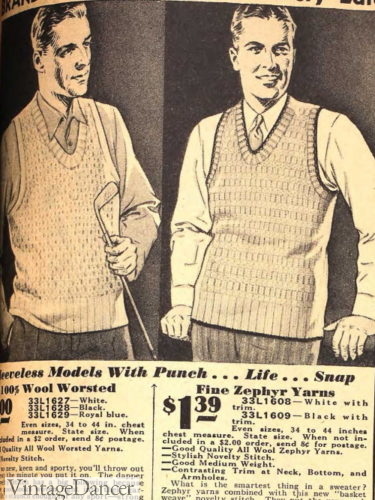
New textures were what everyone talked about in the early to mid 1930s. Waffle, pineapple, cross-grain, basketweave, and tiled knit patterns updated the simple shapes and gave them dimension.
- 1933 RoundNeck Cross Grain and Basket Weave Sweater Vests
- 1938 Pineapple Stitch Sweater Vest
Colors were lighter than previous decades: white, beige, rust red, powder blue, royal blue, light grey, and black. Some sporty models came with white or black edging on the neck, arms, and waistband, mimicking the tennis sweater/cricket sweater/varsity sweater. At the very end of the decade, sweats had more color combinations and even more texture, such as cable knit.
1940s Sweater Vests
The popular Fair Isle, cable knit, and smooth knit sweater vest carried on into the 1940s, but went back to having a V neckline. Still short with a wide waistband, they lengthened a tad, and the shoulder went back to full coverage.
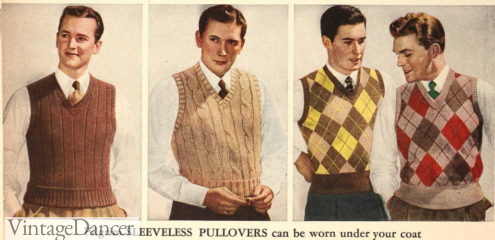
1943 Sweater Vests – Drop Needle, Cable Knit, and Argyle Smooth Knits
The Fair Isle sweater vest was featured well in the early and late 1940s. Updated patterns had rows of Fair Isle as well as brighter colors mixed into the designs.
- 1940 Fair Isle Sweater Vest
- 1948 Fair Isle Sweater Vest
- 1948 Fair Isle Sweater Vest
The cable knit sweater vest was the most popular texture in the 1940s. It looked dashing under a sportscoat with plain white shirt and colored tie. The raised bottom hem looked like it was folded up once to create a smaller waistband.
Other textures were the drop needle (paneled), small shaker, and gridiron, as well as smooth knits.
- 1943 Cable Knit Vest and Sweater
- 1945 Cable Knit Sweater Vest
- 1946 Cable Knit Sweater Vest Under a Sport Coat
Brown, medium tan, blue, powder blue, yellow, red, green, rust, white, and maroon created more variety of colors than previous decades. With suiting being dull through most of the early 40s, these bright colors helped wardrobes not become too depressing.
Occasionally, patterns were added to sweater vests. Nordic ski designs as well as argyle were frequently in demand in winter. This is the decade where argyle became associated with golf attire.
- 1944 Sleeveless Pullovers and Sweater Vests
- 1946 Drop Needle, Baby Shaker, Cable Knit, and Argyle Pattern
Almost all sweater vests were pullovers / slipovers. Sears called them Sleeveless Pullovers, while button-down styles were called Sweater Vests. Button down cardigan types could be yarn knit, but most were made of flat knit cloth. The stiffer fabric retained the waistcoat shape and suit vest look.
- 1945 Flat Knit Sweater Vest
- 1946 Yarn Knit Sweater Vest
Men’s Sweater Vests 1950s to 1980s
- 1950s – Far Isle patterns were popular with the golfer look in the early 50s. Plain colors revived in the later 1950s. Read more.
- 1960s – Knit vests were out of fashion. Woven button down vests were in style. Read more.
- 1970s – Knit vests returned with a vengeance. Longer lengths with belts. Short vests with wide shoulders in bold or classic patterns.
- 1980s- Knit vests were everywhere! They layered over shirts in all the classic colors, patterns and textures. More about 80s menswear.
- 1969 Sportcoats, Vests, Tie, and Trousers – All in Mismatched Colors and Patterns
- 1957 Men’s Sweater and Sweater Vest
- 1974 Men’s Sweater Vest
- 1984 Men’s Sweater Vests
Read More
- Men’s Vintage Sweaters History
- 1920s Men’s Sweaters, Pullovers, Cardigans
- 1940s Men’s Outfit & Costume Ideas – Featuring an outfit with sweater vests
Vintage Sweater Vests to Buy
Genuine vintage men’s sweater vests are prized collectables. They can be difficult to find in good shape and larger sizes. New vintage reproduction sweater vests are a better investment ($$$) but have limited options. New classic sweaters or modern sweater vests can work for an overall vintage look. Usually, modern sweaters are much longer and looser than the short early sweater vests (order one size smaller and have them hemmed up/taken in). Patterns are often limited to argyle and Fair Isle with white cricket/tennis/varsity sweater vests in the spring.
We keep an eye out for the most affordable men’s vintage style sweater vests and link to them here.
Debbie Sessions has been teaching fashion history and helping people dress for vintage themed events since 2009. She has turned a hobby into VintageDancer.com with hundreds of well researched articles and hand picked links to vintage inspired clothing online. She aims to make dressing accurately (or not) an affordable option for all. Oh, and she dances too.
